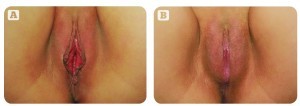Due to the effects of childbirth, ageing, trauma, and/or genetics, the vaginal tissue and surrounding muscles can become stretched and lose their strength and tone. Labial enlargement, unevenness, or traumatic tears from childbirth also affect the appearance of the labia, which may result in discomfort with intimate contact, chronic rubbing, pulling sensation, vulva pain, and discomfort when wearing certain types of clothing, such as jeans or swimsuits.
Aesthetic vulvovaginal surgery (AVS), also called female genital cosmetic surgery (FGCS), cosmetic vaginal surgery, or cosmetic gynaecologic surgery, is an umbrella term for various surgical procedures performed to improve the appearance or function of the vulvovaginal region. Aesthetic and functional techniques include traditional vaginal prolapse procedures, as well as cosmetic vulva and labial procedures. These consist of elective minimally invasive surgeries, such as vaginoplasty (vaginal tightening techniques), perineoplasty for vaginal tightening, labia minora plasty for hypertrophic or irregularly shaped labia minora, clitoral hood reduction for an excessively large clitoral hood, labia majora plasty for enlarged or lax labia majora, or labia majora augmentation for hypotrophic labia majora.
The line between cosmetic and medically indicated procedures has become blurred, and many operations are performed for both purposes. Women seeking FGCS need to be educated about the range and variation of ‘normal’ labia widths and genital appearance, and should be evaluated for true pelvic support disorders such as pelvic organ prolapse and stress urinary incontinence1.
Most patients want their prolapse repaired, and their genital area to be tighter and more attractive. The typical age of women seeking labial surgery is 20s to 30s. We also see teens who are athletic and self‑conscious about the way their genital area appears in a bathing suit or shorts. There may be a genetic component and some girls will present with a predisposition to larger labia.
Women post childbirth and those who are back on the dating scene after divorce may seek vaginal tightening or require deep pelvic surgery to correct a prolapse, fallen uterus or rectum. Being able to address the functional as well as aesthetic issues in one stage offers significant advantages in terms of recovery, convenience, and costs.
Ellman’s Pellevé offers versatility
The Pellevé® S5 System (Ellman International, Inc.) is a versatile radiofrequency (RF) device that can be used for both surgical and non‑invasive vaginal tightening. Our practice was the first to perform and develop protocols for non‑surgical labia majora laxity. Formerly, only surgery could help a patient suffering from the unsightly drop of their labia majora and loss of skin tone. Patients who had the ‘camel toe’ appearance or had personal discomfort issues with their labia majora are able to avoid labia majora plasty surgery with this 30-minute non-invasive labial skin tightening technique.
My philosophy is to do the most minimal surgery to get maximum results. Therefore, we can achieve minimal damage to the tissues, with good precision, which is important especially when you are working around tender genital areas. By using the minimally invasive technique, I can perform 98% of the cosmetic work with the patient awake, without IVs, and not experiencing pain. I was the first to use the technique of dermoelectroporation (DEP) for anaesthesia. This transdermal delivery technique utilises the skin’s water based channels to allow macromolecules of the anaesthetic agent to penetrate safely into the tissue so patients are totally comfortable during the procedure. We have perfected a protocol for vaginolplasty using a microtumescent local anaesthetic, without the need for invasive tubes, lines, and spinal needles. The typical labiaplasty uses only 4–7 cc of local anaesthetic. My development of the pudendo-levator block in conjunction to the Lone Star APS Vaginal Retractor™, Alinsod table and stand, and Alinsod uro-gyn scissors have been instrumental in ease and safety of in-office vaginoplasty, perineoplasty, and severe rectoceles and heamorrhoids.
Although it may seem simple to perform a labiaplasty, it is an intricate procedure that requires a great deal of experience and finesse. We have seen more physicians attempting to perform vaginal surgery without the benefit of proper training and good technique. For this reason, approximately one-third of my practice is devoted to functional and aesthetic repairs after labiaplasty or vaginalplasty. The most common complications are too much skin removed, dog ears, ragged edges, asymmetry, and wedge resections that have split open.
I also developed the Alinsod feathering technique using radiofrequency to do revision surgeries without the need for sutures. Ellman’s Surgitron and Pellevé Systems use high frequency RF energy to smooth out irregularities and, therefore, no suturing is needed. The Pellevé Generator is the device of choice for any labial and revision surgery in my practice. Postoperatively, cosmetic patients can walk out of our office on the same day with only oral and topical anaesthetic cream and icing for several days.
The ‘barbie look’ and hybrid labia minora plasty techniques require extremely precise tools and the steadiest of hands to create a refined but natural look that is more than a simple trimming of labia. It needs an artistic eye and ability to plan a few steps ahead for a natural flow of clitoral hood to frenulum to labia minora. With the Pellevé surgical capabilities this is achievable.
We have also achieved excellent results using the Pellevé wrinkle reduction system for face and body skin tightening and wrinkle reduction, including the periorbital area, hands, arms, thighs, and abdomen.
Innovative techniques
The field of urogynecology is constantly evolving and we are at the forefront of new developments. We have developed a technique to avoid hysterectomies by utilising uterine suspensions, which is a much safer procedure with a shorter recovery. I also developed the curvilinear labia majoraplasty. We can restore comfort for women who go horseback riding and bikers who have friction. We remove excess labia majora skin without visible scars by hiding the incisions in the crease of the labia majora and minora. The area looks less bulky and sleeker and eliminates the ‘camel toe’ appearance.




